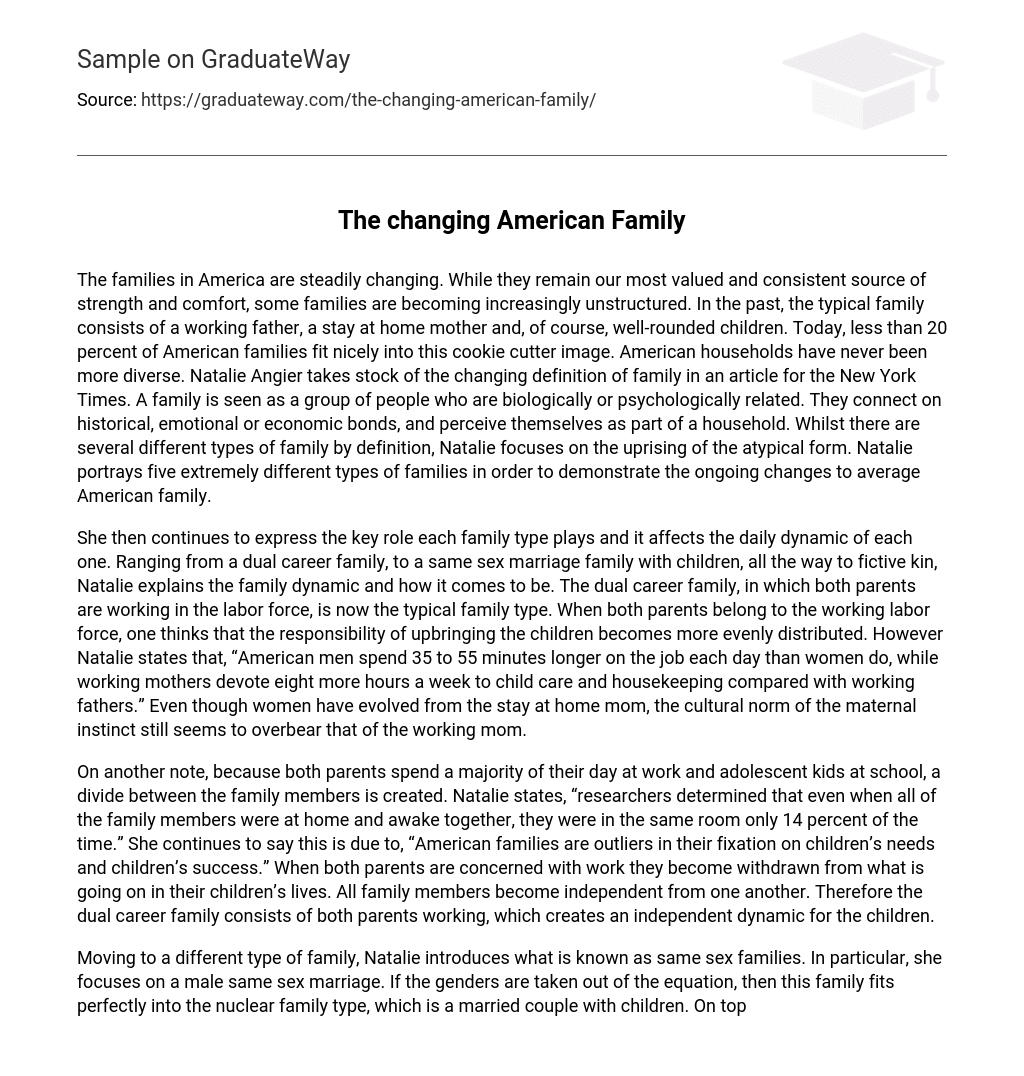The concept of American families is changing, with increased diversity and less adherence to traditional structures. In the past, families typically consisted of a working father, a stay-at-home mother, and well-rounded children. However, this traditional image now only applies to less than 20% of American households. Natalie Angier explores the evolving notion of family in an article for the New York Times. She explains that families are connected through biological or psychological ties and bond through historical, emotional, or economic connections. The idea of family encompasses various definitions, but Natalie specifically focuses on highlighting the rise of non-traditional family forms. By presenting five distinct types of families, she aims to showcase how the average American family is continuously transforming.
According to Natalie, each family type has a significant role in shaping the daily dynamic. From dual career families to same-sex marriage families with children to fictive kin, she explains how the family dynamic is formed. The dual career family, where both parents work in the labor force, has become the typical family type. While one might assume that the responsibility of raising children is more evenly distributed in dual career families, Natalie points out that American men spend 35 to 55 minutes longer at work than women, and working mothers dedicate eight more hours per week to child care and household chores compared to their male counterparts. Despite women moving away from the traditional stay-at-home mother role, the cultural expectation of maternal instinct still outweighs that of working mothers.
On another note, because both parents spend a majority of their day at work and adolescent kids at school, there is a divide between the family members. Natalie states that researchers found that even when all family members were at home and awake together, they were only in the same room 14% of the time. According to her, this happens because American families prioritize children’s needs and success excessively. When both parents are focused on work, they become detached from their children’s lives and all family members become independent from each other. As a result, dual career families, where both parents work, create an independent dynamic for the children.
Natalie introduces same-sex families, specifically focusing on a male same-sex marriage. If the genders are removed, this family perfectly fits into the nuclear family type – a married couple with children. The only difference is that the children have two dads. However, in today’s society, gay marriage and same-sex families are not widely accepted due to cultural lag. The same-sex marriage community challenges social norms as a minority. Many Americans do not have sufficient time to adjust to and integrate this change. Hence, the same-sex community faces challenges, such as being stereotypically accused of causing problems for their children’s adaptation to their lifestyle. These problems include a higher risk of drug and alcohol issues, academic difficulties, and behavioral problems.
Natalie disputes the allegations, citing “The Age of Independence: Interracial Unions, Same-sex Unions, and the Changing American Family,” which states that children raised by same-sex parents achieve academic and emotional success at a comparable rate to those with heterosexual parents. This support has the potential to bring about a shift in American families, enabling same-sex families to live free from discrimination or bias. Consequently, the family dynamics of same-sex couples often resemble those of traditional nuclear families. Furthermore, chosen families consist of individuals one feels obligated to, much like blood relatives. These self-formed families are just as valuable and important as conventional families and are referred to as fictive kinship. The bond within such a family can be established through various means. Natalie clarifies that “for some people, voluntary kinship filled a void left by death or estrangement from biological family, while for others the relationships were supplemental or temporary.”
The fictive kin family, also known as a second family, can be formed through friendship or a sense of belonging. It serves as an alternative to one’s biological family, particularly when it has disappointed them. Fictive kin is characterized by close bonds and strong interconnection, resulting in a unique family dynamic. This concept highlights the diverse forms of the American family, which has evolved from the traditional nuclear family to adapt to changing cultural norms. From dual career families to same-sex marriages and even fictive kin, each family type reflects the dynamics and characteristics of the individuals within it.





